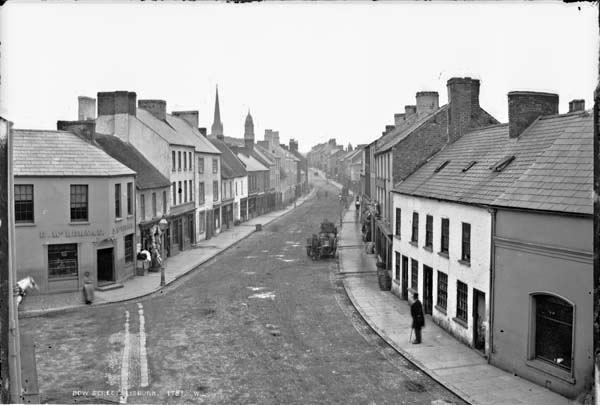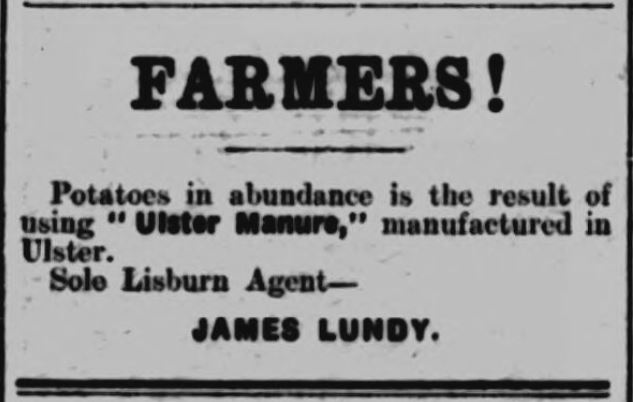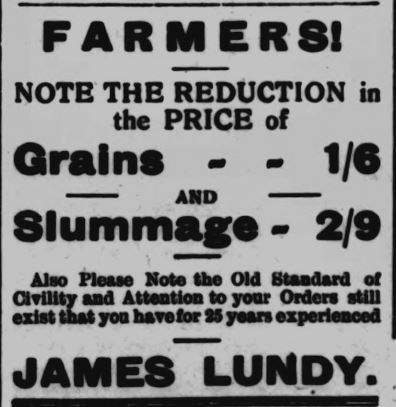
James Lundy left his home village as a young man at the end of the 19th century with ambitions for a better future, and built up a business that sustained his family through good times and bad for some six decades. There were highs and lows along the way, but the night of 23 August, 1920, was one like no other.
That was the night his business, along with those of his neighbours, was targeted by a loyalist mob, who looted and burned their way through the Catholic areas of his adopted hometown of Lisburn over the course of three days. Known as the Lisburn Burnings, these events would have far reaching implications for James and his family.
James Lundy’s early days
James Lundy was my great grandfather. He was born in the village of Dromara, Co Down, on 16 September 1870. The youngest of five children, he set out to Belfast in his early twenties to find work and stayed for a time with his older sister, Margaret, who had married her husband Daniel Keenan and settled in Ballymacarrett in east Belfast some years before.
While in Belfast, James met and married Martha May, the daughter of a butcher from Bridge End in Ballymacarrett. Shortly after the birth of their first child, my grandfather Art, in 1898, the family moved to Lisburn where James soon began operating as a coal merchant.
The Lundys settled in No 65 Longstone Street and James rented a coal shed in nearby Bow Street, and ran a successful business from here for several years. Their little family grew substantially with the arrivals of James, Jennie, Kathleen, Samuel, Jerrod, Hugh, Peggy, John, and Marcia. All but one of the Lundy children – Hugh, who was born in May 1911 and lived for just seven days – survived long into adulthood.
In October 1911 the coal shed in Bow Street was badly damaged in a fire. While the shed was insured, the stock inside was not. And given that the stock amounted to several tonnes of coal, there was little hope of it surviving a fire.

Despite this setback, James ploughed on with the coal business, and in later years expanded his offerings to include manure, hay, and other products which he supplied to local farmers. Within a few years he had built an extensive premises at No 10 Chapel Hill, and moved his family into the house next door at No 12 (No 11 was across the road and did not form part of the Lundy property).
No 10-12 Chapel Hill was an impressive construction. Fronted by a large confectionery and tobacco shop, the business included a spacious internal yard with stores for coal, hay, oats, and other supplies, along with stabling for 30 horses. The house had four bedrooms, two sitting rooms, a kitchen, scullery, and indoor toilet.
This was a stark contrast to James’ early days in Dromara. His parents James and Jane Lundy (born Walker), along with two adult children and numerous grandchildren, were living in a small house in Dromara in 1901, which according to their Census return had just two rooms to accommodate 12 people.
By then James senior worked as a farm labourer, despite being roughly 75 years old (10 years older than what was recorded in the Census) and having a longstanding back injury which was serious enough to have been listed as a contributory factor on his death certificate nearly five years later.
With no land to farm himself, he relied on whatever he could earn helping others. He had previously been a weaver, and was likely paid by the yard for what he produced. The family would have struggled to survive.
A downward spiral begins
James Lundy junior had come a long way from that little house in Dromara, but despite his apparent affluence, in 1920 he was already feeling the pinch. He had offered the Chapel Hill premises for sale in late 1919, but no buyer emerged.
By June 1920 he had another financial setback when his shop was targeted by a young man from Dublin, 16-year-old Patrick Hyland, who cycled to Lisburn from Dublin for a crime spree. Hyland smashed the window of James’ shop, causing £20 worth of damage, a substantial sum at the time, and stealing cigarettes and chocolate from within.
Hyland received three years in borstal for his transgressions when he appeared at Lisburn Assizes and was prosecuted by RIC District Inspector Oswald Swanzy for his burglary of Lundy’s and four other businesses.
DI Swanzy had been redeployed to Lisburn from Cork for his own safety shortly before he prosecuted young Hyland, and he would not survive long in his new home.
Ireland in 1920 was in the midst of the War of Independence, and tensions were running high throughout the country. In the northern counties that would later constitute Northern Ireland, Unionists who were ideologically opposed to, and fearful of, independence from the United Kingdom, were already lobbying for partition in the event of the establishment of an Irish Free State.
Swanzy’s fate was sealed before he went north. In March 1920 Tomas Mac Curtain, Lord Mayor of Cork and leader of the Cork No 1 Brigade of the IRA, was shot dead in front of his wife and son. The killing, carried out by disguised RIC officers, caused widespread public outrage, and Michael Collins reportedly ordered the killing of those responsible.
It was widely believed that Swanzy, RIC District Inspector for Cork at that point, had ordered Mac Curtain’s killing. In a bid to protect him from reprisals he was redeployed to Lisburn, effectively the other end of the country.
The move afforded him little protection, however. Swanzy was shot dead by an IRA squad – who reportedly used Mac Curtain’s gun – in Market Square, Lisburn, while returning home from church on Sunday 22 August, 1920.
Swanzy’s was not the first killing to foment violence in the northern counties that summer.
In July 1920 the IRA shot Lt Colonel Gerald Bryce Ferguson Smyth, who infamously told RIC officers to shoot civilians on sight if they did not put their hands up when challenged.
Though he was killed in Cork, his body was returned to his mother’s home of Banbridge in Co Down for burial. The funeral precipitated three days of violence in the north, including Lisburn, where several shops were looted and burned at the end of July.
The burnings
Swanzy’s killing a few weeks later saw the tension which already existed in Lisburn escalate into an all-out assault on the town’s Catholic minority. By Sunday evening an angry mob was looting and burning its way through Catholic areas, and this continued into Monday and Tuesday.
Fires lit the city for two nights, according to newspaper reports in the following days, and were still burning on Tuesday. Families had their furniture removed from their homes and burned in the street, while others saw their homes reduced to rubble. At one point, rioters cut the hose being used by the Belfast Fire Brigade to extinguish the blazing buildings, and the brigade had no option but to leave the fires to burn.
Among the businesses destroyed in the burnings was Donaghy’s Boot Factory, where the charred remains of an unidentified man were later found in the ruins.
On the Monday evening James Lundy’s shop was “wrecked, looted and set on fire”, along with many neighouring businesses in Chapel Hill. According to numerous reports in the local press the fires in Chapel Hill lit the city through Monday night.
Though the Lundy family home appears to have escaped destruction, the financial damage done to James’ business was substantial.
The aftermath
Like more than 200 others affected by the burnings, James sought compensation for the damage to his shop. He initially lodged a claim for £2,000, though this was later reduced to some £670. When his case for compensation was eventually heard in Belfast Recorder Court the following year, he was awarded just £250.

The burnings had long term consequences for James and his family. He had a mortgage on the property in Chapel Hill, and with declining business and costly repairs he found himself facing bankruptcy. Repeated attempts to sell the property failed to produce a buyer.
James, however, was nothing if not resourceful. As his finances foundered he sought a way to cover his losses, and as a result of his efforts he found himself in court yet again in October 1922, this time as a defendant.
On Sunday morning, 17 September 1922, RIC officers descended on the Chapel Hill premises to search the stores at the back of the shop, where they found a still, some 70 gallons of “illicit spirit” (poitin), and another 65 gallons of wash waiting to be distilled. It was a large operation by any measure.
James pleaded guilty to the charge of having an illicit still, and in his defence said that he had not sold any poitin before the still was discovered. He had taken up distilling because he had fallen on hard times, he was now quite poor and had reluctantly entered into an arrangement with his creditors. As part of this arrangement a first instalment of 3s 4d was due at the end of the month, and he did not have the means to pay it.
Despite his pleas for clemency, James was fined £100, and was given a month to pay the fine. I have found no record of whether James paid this astronomical fine, or whether he appealed it to a higher court.
In any event, James lost everything. Within a few years his home and business were repossessed and sold by the bank.
From what little I have been able to glean of James’ character, he was a quiet and good humoured man who appears to have dealt with life’s slings and arrows with grace. He picked himself up and moved on. The Lundys relocated to nearby Linenhall Street, where James continued his coal business for more than 40 years.
James Lundy died at his home, No 12 Linenhall Street, on 8 August 1964, just a few weeks before his 94th birthday. He is buried in Holy Trinity Cemetery, Lisburn.

Una Sinnott
I love exploring how our ancestors lived, and what we can find out about them from the records they left behind. Get in touch if you need help researching your Irish roots.
